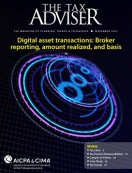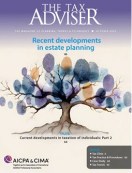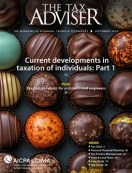- newsletter
- TAX INSIDER

Questions remain about the excess business loss rule
Practitioners need guidance soon on the new excess business loss rule in Sec. 461(l).
Please note: This item is from our archives and was published in 2019. It is provided for historical reference. The content may be out of date and links may no longer function.
Related
The TCJA and state considerations for business
New business interest expense rules issued in proposed form
The TCJA: A disruptive factor for the 2019 tax filing season
P.L. 115-97, informally known as the Tax Cuts and Jobs Act (TCJA), added Sec. 461(l) and the phrase “excess business losses” to the Code. Little has been written about the excess business loss rule. Perhaps people believe it to be straightforward and not worthy of comment. However, IRS guidance is needed to determine items of business income, gains, losses, and deductions to arrive at the amount of excess business losses.
The statutory provision begins with defining the excess business losses as “the excess (if any) of the aggregate deductions of the taxpayer which are attributable to trades or businesses of the taxpayer . . . over the sum of the aggregate gross income or gain of such taxpayer which is attributable to such trades or businesses plus $250,000 (200% of such amount in the case of a joint return)” (emphasis added) (Sec. 461(l)(3)(A)).
Is a business’s income included if the business has no deductions?
The use of the word “such” to modify the phrase “trades or businesses” implies business income and gain is included in the excess business loss computation only if the taxpayer reports deductions from that same business. That interpretation appears overly restrictive, however, and would not encompass all of the business income items on the tax return.
For example, an installment gain recognized in a later year from the sale of business assets of a defunct business (for which no deductions are reported) would not be included in the determination of excess business losses. That seems contrary to the supposed purpose of the statutory provision, i.e., that a taxpayer cannot deduct business losses greater than the sum of business income plus $250,000 ($500,000 for a joint return).
The IRS and Treasury, in drafting guidance for Sec. 461(l), should recognize that all of the taxpayer’s trades or businesses (of both spouses, in the case of a joint return) should be included in the excess business loss computation, regardless of whether the taxpayer sustained deductions or losses from a specific trade or business in the current year.
Wages and compensation as business income
Whether wages and compensation income are business income for determining excess business losses is uncertain. Sec. 461(l) does not specifically exclude wages and compensation from the calculation of the business income, whereas Sec. 199A(d)(1)(B) does explicitly exclude “the trade or business of performing services as an employee” from the term “qualified trade or business” on which the 20% qualified business income amount is computed. Congress would not have needed to specifically exclude the trade or business of performing services as an employee from Sec. 199A if wage income was not business income. Other authorities also consider wage income to be business income.
Losses
In addition, the word “loss” is not found in Sec. 461(l)(3)(A)(i), implying that losses from asset sales are not included in computing excess business losses. Now-repealed Sec. 461(j), addressing excess farm losses, contained similar language. The former excess farm loss worksheets in Schedule F, Profit or Loss From Farming, for Form 1040, U.S. Individual Income Tax Return, provided that if losses from the sale of farm property exceeded gains, the net loss was not included in the determination of the excess farm loss. The guidance on Sec. 461(l) should clarify whether both losses and deductions from the taxpayer’s trades or businesses are included in computing excess business losses.
Looking to Sec. 172 for characterization
Since there is an absence of provisions defining business income otherwise, and since the excess business loss becomes a net operating loss (NOL) in the next year, it is reasonable to assume that those items that are business income, gains, losses, and deductions under Sec. 172 are considered to be the same for Sec. 461(l), unless specifically addressed in Sec. 172. Wages and salary constitute income attributable to the taxpayer’s trade or business for NOL purposes (Regs. Sec. 1.172-3(a)(3)(i)). The sale of business property also generates business gain or loss for NOL purposes (Regs. Sec. 1.172-3(a)(3)(ii)).
Business income should also include income from Schedule C, Profit or Loss From Business, and Schedule F, Profit or Loss From Farming; ordinary business income or loss from partnerships and S corporations reported on Schedule K-1; guaranteed payments for services rendered to partnerships reported on Schedule K-1; and Secs. 1231, 1245, and 1250 gains reported on Form 4797, Sales of Business Property.
Although retirement plan contributions depend upon having earnings from a trade or business, the regulations deny business deduction status to deductions allowed under Sec. 404 attributable to contributions made on behalf of self-employed individuals (Regs. Sec. 1.172-3(a)(3)(iv)). On the flip side, in a contortion of double negatives, losses under Sec. 165(c)(3) not connected with a trade or business are not considered nonbusiness deductions. Instead, they are considered deductions attributable to the taxpayer’s trade or business (Regs. Sec. 1.172-3(a)(3)(iii)). These are specific provisions in Sec. 172(d)(4)(C). Thus, for Sec. 461(l) purposes, a casualty loss from nonbusiness casualties is not considered a business loss and should include Sec. 404 retirement plan contributions as business deductions.
Looking to other Code sections for characterization
In addition, some items are considered business items because of specific provisions in the Code. For example, Sec. 72(b)(3)(C) provides that the deduction for unrecovered investment in an annuity is attributable to the taxpayer’s trade or business. The implication, absent this provision, is that the unrecovered basis in the annuity (and by extension, the annuity itself) is not a business item. This is supported by the treatment of annuity income as nonbusiness income. Annuity income is not treated as business income for Sec. 461(l), nor would the deduction for the unrecovered basis be considered a business deduction. These are not actual business items, but instead are deemed business items for NOL purposes.
Other specific provisions treating losses as attributable to the taxpayer’s trade or business include losses on small business investment company stock (Sec. 1242) and losses on small business stock (Sec. 1244(d)(3)). Absent these specific provisions, those losses would appear not to be business losses. For that reason, this author would exclude those losses from the excess business loss computation, since there is no provision extending the business treatment for a purpose other than Sec. 172.
The deduction for one-half of self-employment taxes is specifically treated as attributable to a trade or business carried on by the taxpayer that does not consist of the performance of services by the taxpayer as an employee (Sec. 164(f)(2)). One wonders, however, if this provision was added to the Code for clarity or to override its treatment otherwise. Those who focus on statutory construction can opine. The author is not an attorney; he notes, though, that there is a presumption that Congress uses the same term consistently in different statutes (Smith , 508 U.S. 223 (1993)). For example, wage income is considered business income for purposes of Sec. 179 (see Regs. Secs. 1.179-2(c)(6)(iv) and (c)(1)). The author would include the 50% deduction for self-employment tax as a business item because it is designed to add parity to the deduction for the employer share of Federal Insurance Contributions Act and Medicare taxes (although imperfectly). However, an ordering rule may be necessary. If the business loss is suspended, is the self-employment loss associated with the suspended business loss also suspended?
Looking to IRS guidance for characterization
The state income tax deduction of individual taxpayers attributable to business income is a business deduction for NOL purposes (Rev. Rul. 70-40). (As a side note: This aspect of state income tax deductions requires guidance as to whether taxpayers may choose the state income tax deduction attributable to business as the first deduction to arrive at the maximum $10,000 itemized deduction under Sec. 164(b)(6). The ordering of the $10,000 limitation is important in the NOL determination. At this point, it is uncertain whether a taxpayer may assume that the state income tax deduction is attributed to state income tax on business income first, to real property tax next, and finally to state income tax attributable to nonbusiness income.)
The deduction for self-employed health insurance is also considered a business deduction (IRS Publication 536, Net Operating Losses (NOLs) for Individuals, Estates, and Trusts).
Guidance is needed
The excess business loss provision is more complex than it would otherwise appear. Treasury and the IRS should provide guidance as soon as possible to address the questions of whether wage income (from whatever source) is included in the computation, and confirm that installment sale income sourced from a prior year’s trade or business is included in the computation, even though no deductions or losses were incurred from that trade or business in the year of the excess business loss determination.
Editor’s Note: On Feb. 28, the AICPA submitted comments to Treasury and the IRS, requesting guidance on various issues related to Sec. 461(l).
Christopher W. Hesse, CPA, is a principal in the National Tax Office of CliftonLarsonAllen LLP. He is the vice chair of the AICPA Tax Executive Committee. To comment on this article or to suggest an idea for another article, please contact Sally Schreiber, senior editor, at Sally.Schreiber@aicpa-cima.com.














